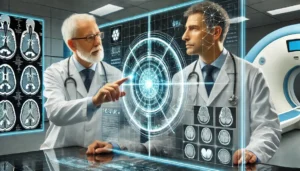Rapid advances in robotics are changing the future of automation in ways unimaginable just a decade ago. As business demands continue to grow, robotics is bringing ever more efficient, faster, and safer improvements to production lines, services, and everyday life. These new technologies not only simplify demanding tasks but also offer individuals and businesses smarter ways to work.
The shift to intelligent, flexible, and collaborative robotic systems marks a turning point in global automation development. Every year, new research emerges demonstrating the application of robotics in areas previously considered difficult to automate. These innovations lay the foundation for the future, from advanced manufacturing to personalized healthcare. In the following article, we explore the key factors driving this remarkable transformation.
Next-Generation Collaborative Robots:
Collaborative robots herald a new era in which humans and technology can work together with astonishing precision and safety. Traditionally, industrial robots had to be isolated from humans. Today, collaborative robots are equipped with sensor technology, allowing them to detect the presence of humans and adjust their movements instantly. This makes them ideal for small and medium-sized businesses looking to improve efficiency without compromising the safety of their employees.
They can support a variety of tasks, including assembly, inspection, and packaging, which reduces workloads. These high-tech devices require minimal programming to perform various tasks, saving companies time and allowing them to quickly adapt to new demands. The development of collaborative robots demonstrates that automation solutions are increasingly collaborating with humans, rather than replacing them. As more businesses use these solutions, we can expect processes to go more smoothly, mistakes to happen less often, and productivity to go up in many areas.
AI-Driven Autonomous Robots:
Artificial intelligence is taking robotics to a new level, enabling robots to make autonomous decisions based on constantly changing data. Autonomous robots can learn from their environment and respond intelligently to unforeseen situations, while traditional robots can only follow predefined instructions. This capability is transforming sectors like logistics, where robots can autonomously navigate warehouses, move goods, and improve storage systems. In agriculture, AI robots can observe soil, identify crop problems, and perform specific tasks, increasing productivity.
These solutions reduce human error, minimize downtime, and ensure smooth operation in diverse environments. Thanks to continuous improvements in machine learning algorithms, autonomous robots are becoming more flexible and practical. They can process enormous amounts of data, improving their performance and contributing to the development of safer and more reliable automation solutions. With the continued development of artificial intelligence, these robots will have an even greater impact on the future of business.
Improvements in Robot Vision Systems:
Robot vision systems are making significant advances, making it easier for machines to perceive the world. Thanks to high-resolution sensors, depth-sensing technology, and AI-driven recognition algorithms, modern robots can now understand visual information almost as well as humans. These improvements enable robots to perform tasks such as object recognition, quality inspection, and navigation with astonishing precision.
Robot vision is crucial for industries such as manufacturing, helping to detect product defects and maintain high quality. Robot vision supports surgical robots in healthcare by providing clearer images and real-time visual assistance. These devices are more reliable because they can operate under various lighting conditions and in different environments. As visual technology advances, robots will be able to perform increasingly complex tasks, making automation more reliable and practical in numerous sectors.
New Developments in Humanoid Robots and Service Robots:
Humanoid robots and service robots are becoming increasingly capable of tasks previously performed by humans, as their mobility, balance, and decision-making algorithms improve. These robots can greet customers, deliver packages, provide hotel services, and even assist patients in medical settings. Humanoid robots are invaluable in situations where communication and customer interaction are crucial, as they are designed to communicate naturally with people.
Their applications extend far beyond customer service; they are also used in education, elderly care, and other human-focused sectors. They are becoming increasingly intelligent, able to understand gestures, answer questions, and perform tasks correctly. Researchers continue to refine these technologies, and humanoid robots are expected to become important assistants in everyday life, supporting rather than challenging people.
Conclusion:
With the continued emergence of new technologies and the increasing pace of innovation, the future of robotics looks bright. To make operations more flexible, safe, and efficient, companies are rapidly turning to smarter automation solutions. Robotics will continue to improve thanks to developments in materials, artificial intelligence, and human-robot collaboration technologies. These changes will create new opportunities in transportation, healthcare, agriculture, and many other service industries.
Robots will be able to learn autonomously, adapt to new environments, and perform tasks that were previously impossible to automate. As robotics becomes increasingly commonplace in everyday life, machines will become smarter partners, both at work and in life. Despite the need to address issues like cost, maintenance, and ethics, robotics is undoubtedly on the path to innovation. As technology continues to develop, robotics will continue to be a key driver of modernization and digital transformation, shaping the future.
FAQs:
1. Which types of businesses benefit most from modern robotics?
Modern robotics has had a significant impact on industries such as manufacturing, healthcare, logistics, agriculture, and retail, improving efficiency, accuracy, and safety.
2. How do collaborative robots improve workplace productivity?
Collaborative robots can assist with repetitive or highly precise tasks, freeing up human workers to focus on more challenging tasks and increasing productivity.
3. Are autonomous robots difficult to set up?
Setting up an autonomous robot for the first time may require some technical knowledge, but current robot designs are easy to use, with user-friendly interfaces and customizable programming methods.
4. Why is robot vision crucial for automation?
Robot vision technology enables robots to detect defects more accurately and reliably, identify objects, and navigate their environment more easily.
5. Will robots replace human jobs?
Robots will likely collaborate more effectively with humans and perform repetitive tasks, while humans focus on decision-making, innovation, and interpersonal communication.




